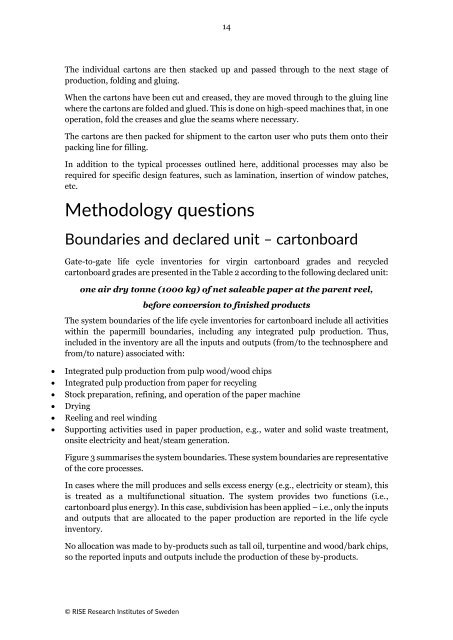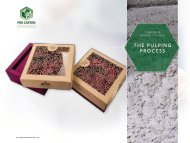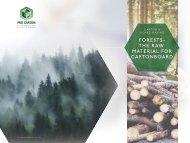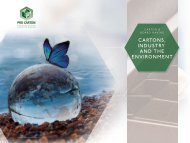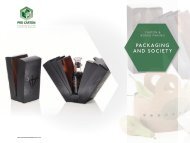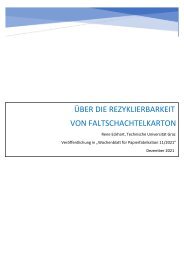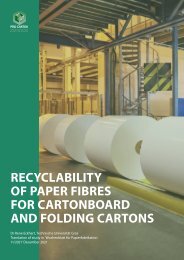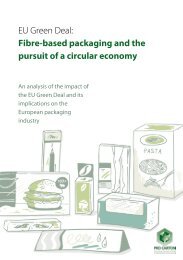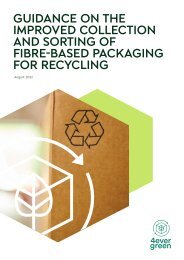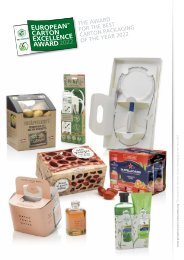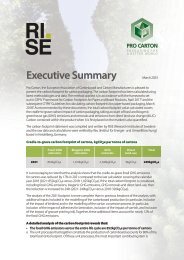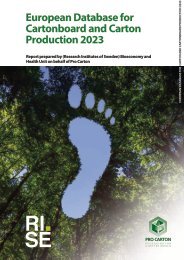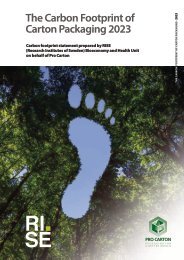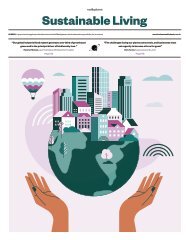European database for cartonboard and carton production, 2023
You also want an ePaper? Increase the reach of your titles
YUMPU automatically turns print PDFs into web optimized ePapers that Google loves.
14<br />
The individual <strong>carton</strong>s are then stacked up <strong>and</strong> passed through to the next stage of<br />
<strong>production</strong>, folding <strong>and</strong> gluing.<br />
When the <strong>carton</strong>s have been cut <strong>and</strong> creased, they are moved through to the gluing line<br />
where the <strong>carton</strong>s are folded <strong>and</strong> glued. This is done on high-speed machines that, in one<br />
operation, fold the creases <strong>and</strong> glue the seams where necessary.<br />
The <strong>carton</strong>s are then packed <strong>for</strong> shipment to the <strong>carton</strong> user who puts them onto their<br />
packing line <strong>for</strong> filling.<br />
In addition to the typical processes outlined here, additional processes may also be<br />
required <strong>for</strong> specific design features, such as lamination, insertion of window patches,<br />
etc.<br />
Methodology questions<br />
Boundaries <strong>and</strong> declared unit – <strong><strong>carton</strong>board</strong><br />
Gate-to-gate life cycle inventories <strong>for</strong> virgin <strong><strong>carton</strong>board</strong> grades <strong>and</strong> recycled<br />
<strong><strong>carton</strong>board</strong> grades are presented in the Table 2 according to the following declared unit:<br />
one air dry tonne (1000 kg) of net saleable paper at the parent reel,<br />
be<strong>for</strong>e conversion to finished products<br />
The system boundaries of the life cycle inventories <strong>for</strong> <strong><strong>carton</strong>board</strong> include all activities<br />
within the papermill boundaries, including any integrated pulp <strong>production</strong>. Thus,<br />
included in the inventory are all the inputs <strong>and</strong> outputs (from/to the technosphere <strong>and</strong><br />
from/to nature) associated with:<br />
• Integrated pulp <strong>production</strong> from pulp wood/wood chips<br />
• Integrated pulp <strong>production</strong> from paper <strong>for</strong> recycling<br />
• Stock preparation, refining, <strong>and</strong> operation of the paper machine<br />
• Drying<br />
• Reeling <strong>and</strong> reel winding<br />
• Supporting activities used in paper <strong>production</strong>, e.g., water <strong>and</strong> solid waste treatment,<br />
onsite electricity <strong>and</strong> heat/steam generation.<br />
Figure 3 summarises the system boundaries. These system boundaries are representative<br />
of the core processes.<br />
In cases where the mill produces <strong>and</strong> sells excess energy (e.g., electricity or steam), this<br />
is treated as a multifunctional situation. The system provides two functions (i.e.,<br />
<strong><strong>carton</strong>board</strong> plus energy). In this case, subdivision has been applied – i.e., only the inputs<br />
<strong>and</strong> outputs that are allocated to the paper <strong>production</strong> are reported in the life cycle<br />
inventory.<br />
No allocation was made to by-products such as tall oil, turpentine <strong>and</strong> wood/bark chips,<br />
so the reported inputs <strong>and</strong> outputs include the <strong>production</strong> of these by-products.<br />
© RISE Research Institutes of Sweden


